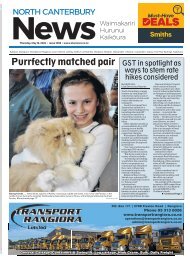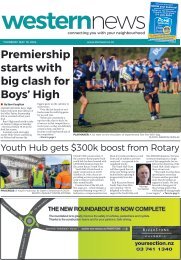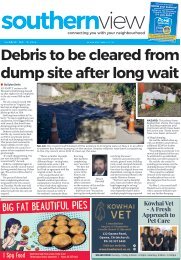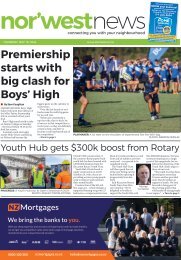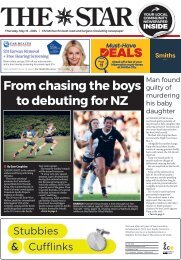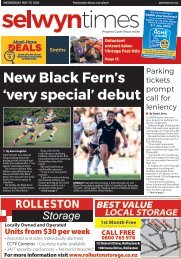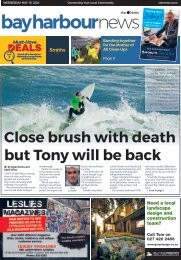The Star: May 19, 2022
You also want an ePaper? Increase the reach of your titles
YUMPU automatically turns print PDFs into web optimized ePapers that Google loves.
<strong>The</strong> <strong>Star</strong> Thursday <strong>May</strong> <strong>19</strong> <strong>2022</strong><br />
20<br />
BUSINESS<br />
Latest Canterbury news at starnews.co.nz<br />
Vodafone, Commerce Commission<br />
both appeal record $2.24m fine<br />
• By Chris Keall<br />
VODAFONE NZ and the<br />
Commerce Commission both<br />
say they’ll appeal a $2.24 million<br />
fine over the telco’s historic<br />
“FibreX” marketing.<br />
<strong>The</strong> regulator says the fine,<br />
which was handed down in the<br />
Auckland District Court on<br />
April 14, is too low to act as a<br />
deterrent.<br />
<strong>The</strong> telco wants to overturn<br />
both the fine and the High<br />
Court conviction that led to the<br />
penalty.<br />
On April 3 last year, Vodafone<br />
was found guilty of misleading<br />
consumers with its 2016-2018<br />
“FibreX” marketing campaign<br />
for the hybrid fibre-coaxial (aka<br />
copper) cable service it offers in<br />
parts of Christchurch, the Kapiti<br />
Coast and Wellington. It began<br />
as a cable TV service operated by<br />
Telstra Saturn, and was inherited<br />
by Vodafone when it bought<br />
TelstraClear in 2012. Vodafone<br />
says it’s spent tens of millions on<br />
upgrades since.<br />
Charges were brought under<br />
the Fair Trading Act and the<br />
telco faced potential fines of<br />
up to $16m. <strong>The</strong> ComCom had<br />
sought a $5.8m penalty.<br />
Judge Pippa Sinclair found<br />
Vodafone’s branding and advertising<br />
was liable to mislead<br />
MARKETING: Fibre X promoted at a Vodafone store in October 2017.<br />
PHOTO: CHRIS KEALL/NZ HERALD<br />
consumers into thinking that the<br />
FibreX branded service was part<br />
of the UFB fibre network.<br />
She rejected Vodafone’s argument<br />
that consumers would<br />
understand that FibreX was a<br />
“fibre-like” network delivering<br />
superfast reliable broadband but<br />
not pure fibre, due to the ‘X’ in<br />
its name.<br />
Commerce Commission<br />
chair Anna Rawlings said this<br />
morning that the $2.25m fine<br />
did not appropriately reflect the<br />
seriousness of the offending, and<br />
the size and financial resources<br />
of Vodafone.<br />
<strong>The</strong> commission will argue<br />
in its appeal that Vodafone’s<br />
conduct was wilful, rather than<br />
grossly careless, and allowed<br />
Vodafone to make significant<br />
commercial gains, Rawlings said.<br />
“<strong>The</strong> fines imposed for this<br />
type of offending must be<br />
significant enough to deter<br />
Vodafone and other large<br />
businesses from engaging in this<br />
type of conduct in the future.”<br />
“We are very disappointed<br />
with the outcome and<br />
respectfully disagree with the<br />
court’s decisions,” Vodafone NZ<br />
said in a statement.<br />
“Our appeal will set out<br />
our strong belief that there<br />
are several errors with the<br />
original conviction decision<br />
and that there are aspects of the<br />
FibreX judgment that simply<br />
misunderstand the services<br />
we sell and are not in the best<br />
interests of consumers or future<br />
competition.”<br />
<strong>The</strong> telco says its HFC service<br />
does indeed offer fibre-like<br />
service, and says that has been<br />
proven by the Commerce<br />
Commission’s own benchmark<br />
testing, which found that, in<br />
Vodafone’s summary, 100 per<br />
cent of HFC Max plans were all<br />
able to stream four simultaneous<br />
UHD (ultra high definition or<br />
4K) Netflix streams, offering an<br />
equivalent experience to Fibre to<br />
the Home plans in this respect.<br />
<strong>The</strong> twin appeals come a<br />
day after the telco industry<br />
introduced two new marketing<br />
codes, at the Commerce<br />
Commission’s direction, which<br />
are aimed, in part, at boosting<br />
customer rights and making<br />
it easier to compare different<br />
broadband options.<br />
—NZ Herald<br />
Merger, acquisition activity still high – PwC<br />
• By Jamie Gray<br />
MERGER AND acquisition<br />
(M&A) activity in New Zealand<br />
remained high in the first<br />
quarter, with private equity<br />
investors again featuring<br />
prominently, PwC said.<br />
Corporate activity in the<br />
education technology sector is<br />
booming and PwC said it was<br />
not seeing any signs of a slowdown.<br />
Deal volume is in line with<br />
levels seen throughout 2021 – a<br />
record year, PwC said.<br />
A number of 2021 deals also<br />
continued into <strong>2022</strong> and have<br />
been announced in this first<br />
quarter.<br />
Healthcare and educational<br />
technology featured strongly in<br />
the data.<br />
Significant levels of deal activity<br />
continued during the first<br />
quarter of <strong>2022</strong> with 45 deals<br />
completed or announced.<br />
“While this is below the<br />
numbers we saw in Q2, Q3, and<br />
Q4 of 2021, it is still considerably<br />
higher than pre-pandemic levels<br />
and more than Q1 2021,” PwC<br />
said.<br />
Regan Hoult, corporate<br />
finance leader at PwC told the<br />
Herald M&A activity had driven<br />
by a combination of factors.<br />
“Looking at the data, there<br />
has been strong international<br />
interest.<br />
“<strong>The</strong> other<br />
theme that came<br />
through was<br />
strong private<br />
equity activity<br />
throughout the<br />
quarter.<br />
Regan<br />
Hoult<br />
“We continue<br />
to see private<br />
equity, both on<br />
the demand<br />
side of transactions – being big<br />
acquirers of businesses and also<br />
ultimately suppliers of businesses,”<br />
he said.<br />
Low interest rates have helped<br />
corporate balance sheets and<br />
how they look at acquisitions.<br />
“Institutions are looking at<br />
private equity as an asset class<br />
that can provide strong returns<br />
against the other asset classes,<br />
which ultimately flows through<br />
into deal activity.<br />
“Yes, there are definitely headwinds<br />
around inflation, supply<br />
chains, rising interest rates and<br />
the geopolitical situation, but<br />
there is still a lot of private equity<br />
capital looking to invest,” Hoult<br />
said.<br />
Corporates “may sit on their<br />
hands”, focus on their balance<br />
sheets, and look at their strategy<br />
in the current environment.<br />
“With the challenges that<br />
STEADY: PwC says private equity investment in New<br />
Zealand companies has continued unabated in the first<br />
quarter.<br />
PHOTO: NZ HERALD<br />
come up through supply chain<br />
issues and inflation, consolidation<br />
can often be something that<br />
can drive value,” he said.<br />
In its report, PwC said that in<br />
education technology (EdTech),<br />
products that demonstrate<br />
improved learning outcomes<br />
and means of adapting learning<br />
to changing learner and teacher<br />
expectations are increasingly<br />
sought after.<br />
Since the beginning of the<br />
Covid-<strong>19</strong> outbreak in early 2020,<br />
PwC has advised on three New<br />
Zealand based EdTech transactions<br />
with international investors<br />
– Totara Learning, Education<br />
Perfect, <strong>The</strong> Mind Lab.<br />
Buyer interest in the sector<br />
was not showing any signs of<br />
reducing<br />
PwC expects to see robust deal<br />
activity continue throughout<br />
<strong>2022</strong> due to the significant<br />
amounts of capital still available<br />
in the market.<br />
“Strong valuations and increasing<br />
market uncertainty may<br />
lead to business owners wanting<br />
to accelerate the timing of exits.”<br />
PwC cross-border deal flow<br />
was strong in the quarter -–20<br />
of the 45 deals involved offshore<br />
buyers.<br />
Australia (nine deals) and the<br />
USA (six deals) continued to drive<br />
international buyer activity.<br />
<strong>The</strong> technology, media and telecoms<br />
(TMT) sector continued<br />
to see the most activity, while<br />
financial services and industrials<br />
and chemicals also featured<br />
prominently.<br />
TMT (14 deals) accounted for<br />
almost a third of all activity during<br />
the quarter.<br />
Nine of the 45 deals announced<br />
during Q1 <strong>2022</strong> involved<br />
a private equity buyer.<br />
Over the last couple of years<br />
M&A activity in the healthcare<br />
sector had significantly increased<br />
and valuations were higher than<br />
ever before, PwC said.<br />
<strong>The</strong>re have been a number of<br />
substantial transactions in recent<br />
months including the sale of<br />
Evolution Healthcare, Canopy<br />
Cancer, Fertility Associates,<br />
Pacific Radiology, Obex Medical<br />
and <strong>The</strong> Selwyn Foundation’s<br />
aged-care assets.<br />
Work on healthcare-related<br />
transactions in the past year<br />
would represent circa 20 per cent<br />
of PwC’s M&A related work.<br />
“Covid-<strong>19</strong> has heightened<br />
investor awareness in the healthcare<br />
sector and the importance<br />
of the health system, leading to<br />
increased interest and activity,”<br />
the report said.<br />
—NZ Herald





